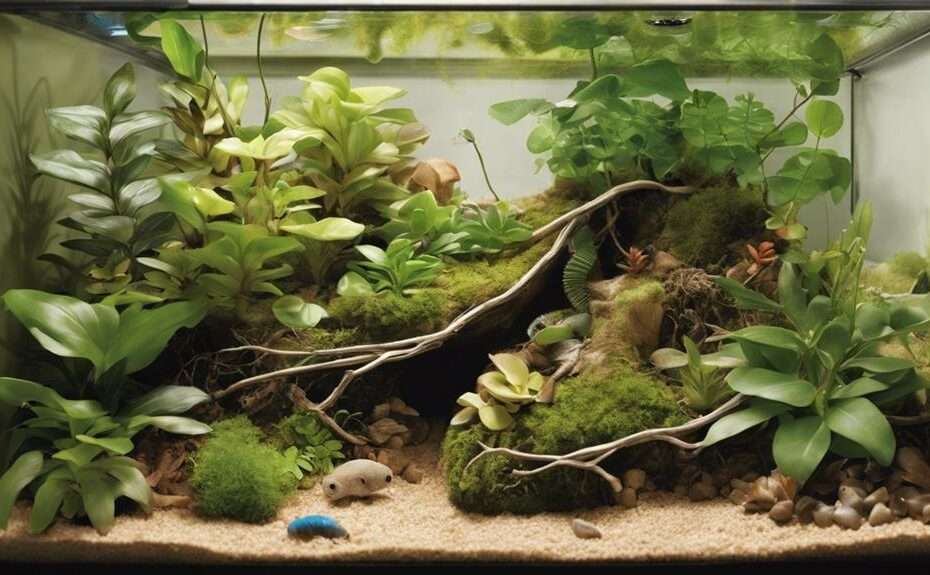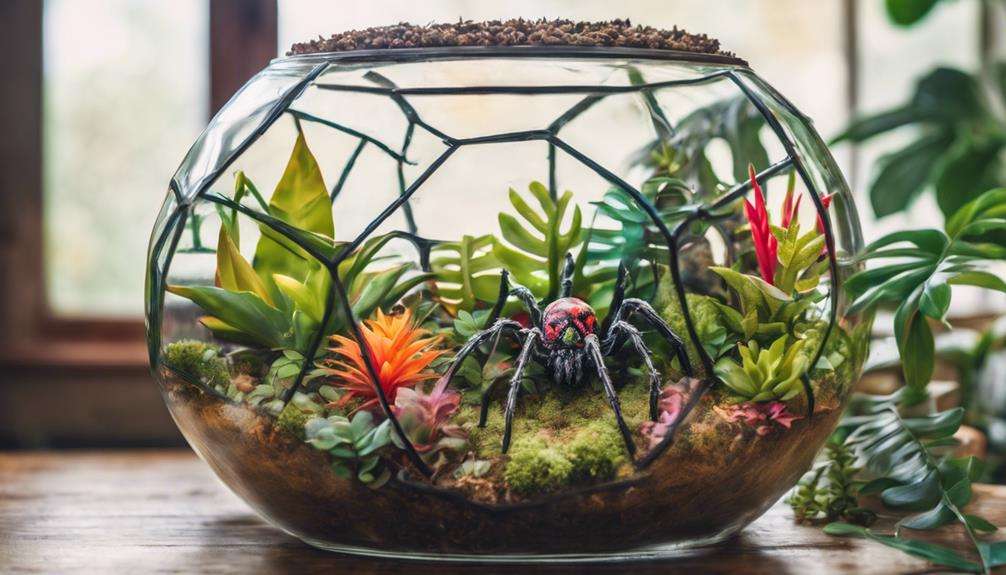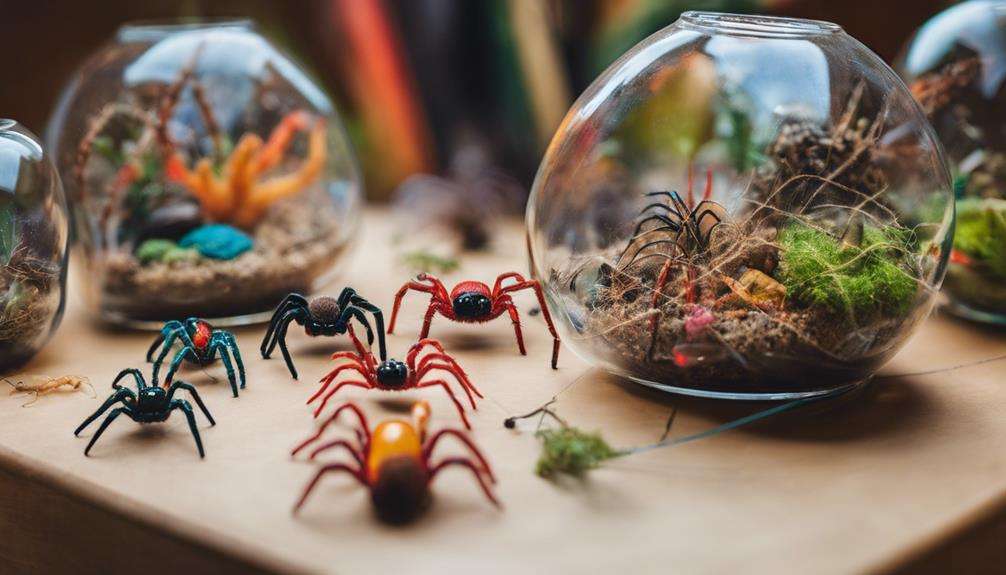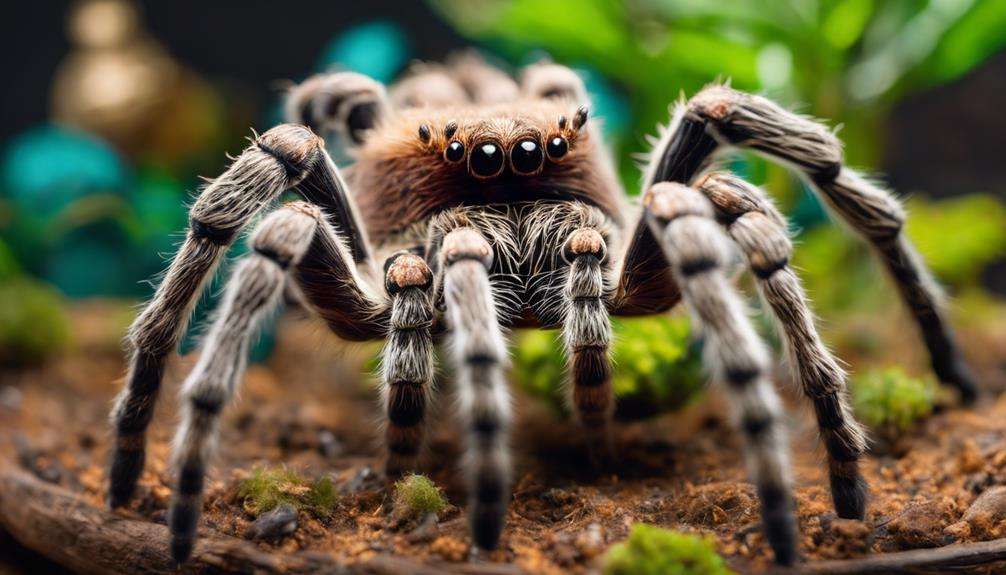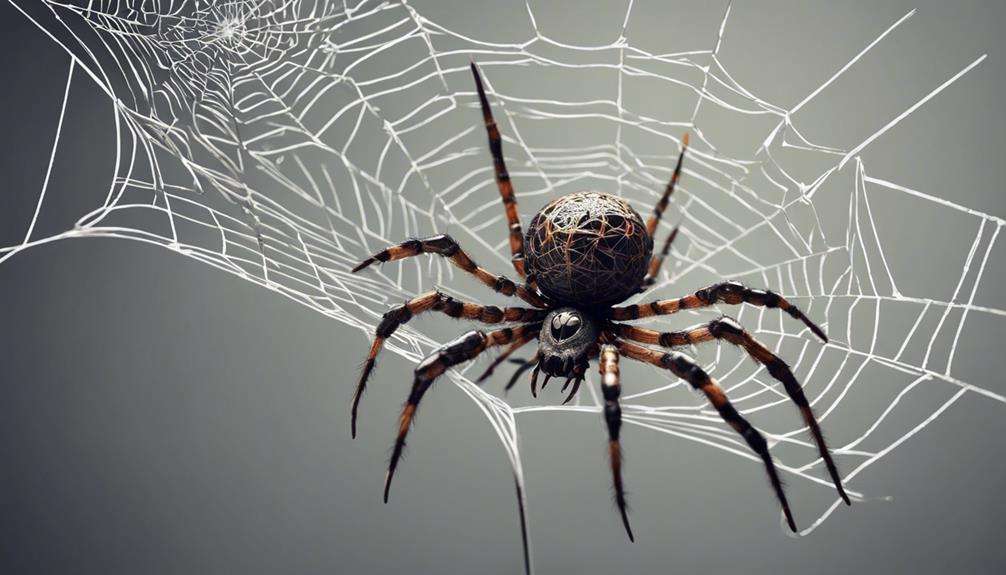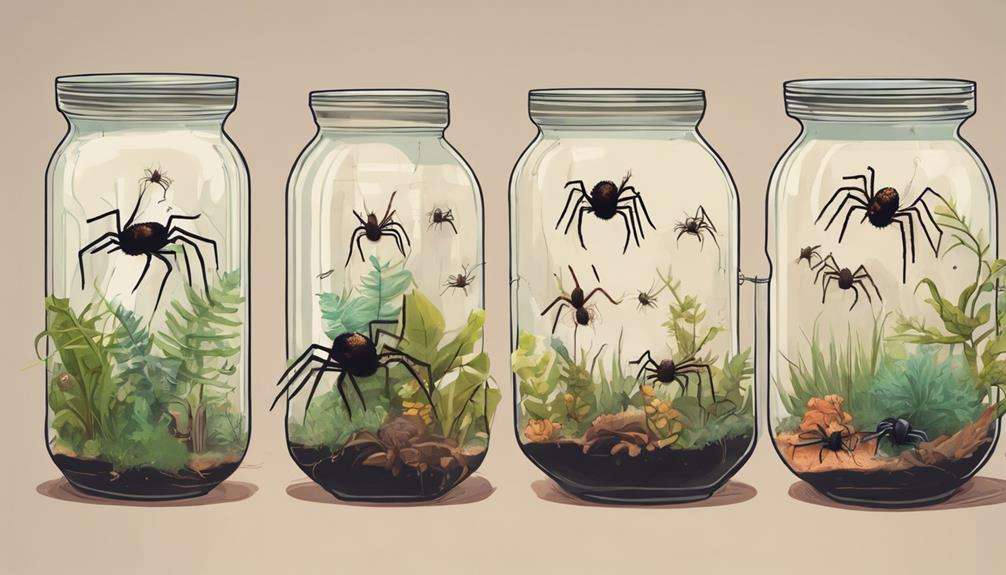Imagine creating a miniature world for your pet tarantula, where every detail is carefully designed to make them feel at home.
But what exactly are the ideal habitats for these fascinating creatures? From the depth of the substrate to the height of the climbing decorations, every aspect plays a vital role in providing a suitable environment.
Let's explore the key elements that go into crafting the perfect habitat for your pet tarantula.
Key Takeaways
- Choose beginner-friendly species like Chilean Rose Hair or Mexican Red Knee for ideal pet tarantulas.
- Maintain proper feeding, hydration, temperature, and humidity levels in the tarantula habitat.
- Create a secure enclosure with climbing structures, hiding spots, and suitable substrate.
- Implement a regular cleaning and maintenance routine to ensure a healthy environment for pet tarantulas.
Top Tarantula Species for Beginners
When selecting your first pet tarantula species, consider the Chilean Rose Hair, Mexican Red Knee, Curly Hair, and Antilles Pink Toe for their docile nature and manageable care requirements.
These beginner tarantula species are favored by novices for their hardiness and longevity in captivity. The Chilean Rose Hair, scientifically known as Grammostola rosea, is a popular choice due to its calm temperament and relatively undemanding care needs.
The Mexican Red Knee, or Brachypelma hamorii, is another excellent option known for its striking appearance and easy maintenance. The Curly Hair tarantula, Brachypelma albopilosum, is a gentle species ideal for beginners seeking a low-maintenance pet.
Lastly, the Antilles Pink Toe (Avicularia versicolor) is a colorful and docile arboreal tarantula that thrives with proper care. Each of these species has specific care requirements, such as temperature and humidity levels, that are relatively straightforward to meet, making them perfect choices for those new to tarantula keeping.
Tarantula Feeding and Water Needs
To maintain the best health and well-being of your pet tarantula, maintaining a proper feeding and water regimen is essential. Pet tarantulas require a diet primarily consisting of live insects such as crickets, mealworms, and roaches to thrive.
It's important to provide a shallow water dish in the enclosure to make sure your tarantula stays hydrated. When feeding your tarantula, avoid using wild-caught insects that may have been exposed to pesticides, as this could harm your pet.
Adjust the feeding frequency according to your tarantula's species and age for the best health. Enhance your tarantula's diet by gut-loading insects with nutritious foods and dusting them with supplements to provide essential nutrients.
Paying close attention to your tarantula's feeding habits and ensuring proper hydration are key aspects of maintaining a healthy diet for your pet tarantula.
Maintaining Temperature and Humidity Levels
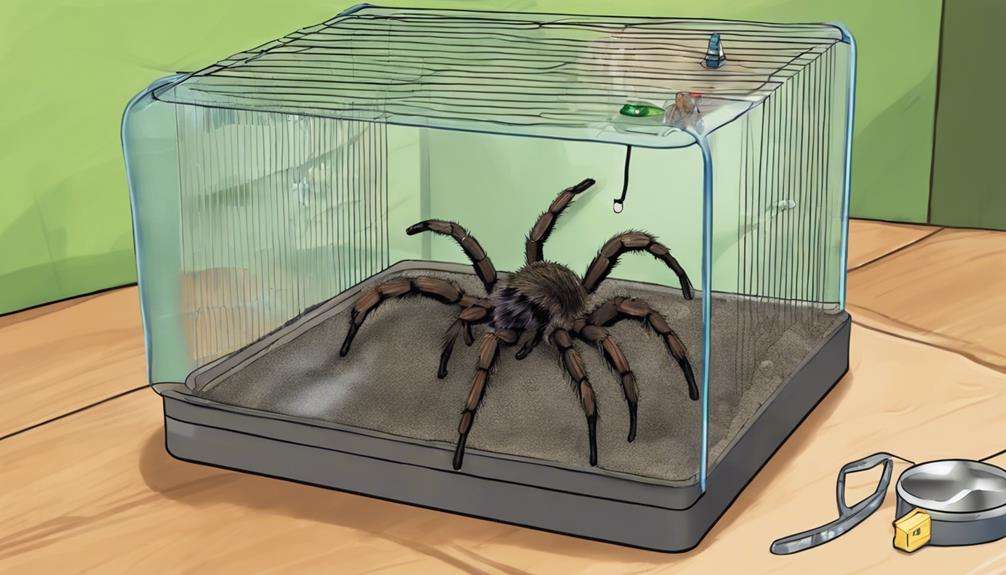
Maintain the temperature within a range of 70°F to 85°F to guarantee ideal well-being for pet tarantulas. Use heaters or heat pads to regulate the temperature effectively.
It's important to monitor humidity levels, keeping them between 70-80% to create a suitable environment for most pet tarantula species. Regularly misting the enclosure will help maintain proper humidity levels essential for the health of your pet tarantula.
Be vigilant to prevent overheating by monitoring temperature levels closely and adjusting heating sources as needed. Maintaining the correct temperature and humidity levels is essential in providing a comfortable and healthy habitat for your pet tarantula.
Setting Up the Perfect Tarantula Enclosure
Select a tank with a secure locking screen top, such as a 20-gallon aquarium, to secure proper ventilation and prevent escapes when setting up the ideal tarantula enclosure.
Consider the specific species of tarantula you have, as their habitat preferences vary; some are terrestrial, while others are arboreal.
Provide climbing structures like rocks or branches to mimic their natural environment and cater to their climbing behaviors. Make sure there are hiding spots within the enclosure, such as flower pots or reptile caves, to offer your tarantula a sense of security and privacy.
Utilize a soft, absorbent substrate like coconut coir and incorporate natural decor such as branches and vines to create a comfortable and stimulating environment for your tarantula.
Maintaining the appropriate temperature within the enclosure is important for the well-being of your pet tarantula, so be sure to monitor and adjust as needed based on their species' requirements.
Proper Cleaning and Maintenance Routine
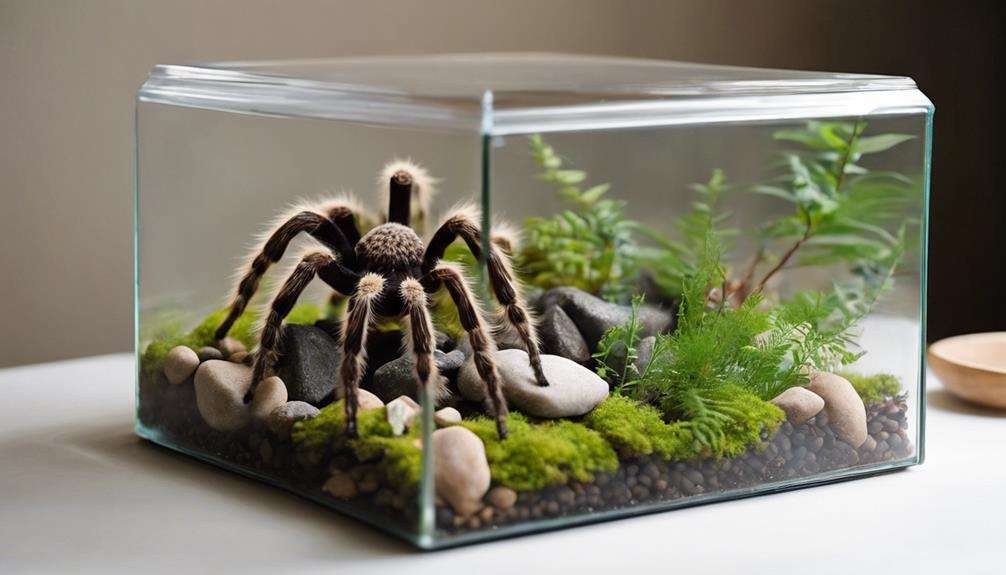
When ensuring the cleanliness and hygiene of your pet tarantula's habitat, it's essential to establish a regular cleaning and maintenance routine. Clean the enclosure as needed to prevent mold, bacteria, and mites buildup. Every 4 to 6 months, perform a deep clean to maintain a healthy environment for your pet tarantula.
During deep cleaning, replace the substrate to maintain cleanliness and prevent health issues. Regularly scrub the water dish to prevent bacterial growth and provide clean water for your tarantula. Before cleaning the habitat, transfer your tarantula to a secure container to prevent escapes and minimize stress.
Proper cleaning is critical in maintaining a suitable environment for your pet tarantula's well-being. By following a consistent cleaning and maintenance routine, you can maintain a clean and healthy habitat for your beloved pet.
Frequently Asked Questions
What Is the Best Habitat for a Pet Tarantula?
For a pet tarantula, create an ideal habitat in a 5-10 gallon tank with secure mesh top. Guarantee proper substrate for burrowing, climbing structures, hiding spots, and a shallow water dish. Preserve temperature, humidity, and clean regularly for their well-being.
What Habitat Do Tarantulas Like?
In creating a habitat tarantulas like, consider a setup with suitable substrate for burrowing, humid hideout, artificial foliage, climbing branches, temperature gradient, water dish, ventilation holes, feeding schedule, and nesting material. These elements guarantee their well-being.
Where Is the Best Place to Keep a Tarantula?
In a quiet area with minimal commotion, keep your tarantula safe. Make a tight-fitting screen top to prevent escape. Provide climbing rocks and branches, hiding spots like flower pots, and consider natural behaviors for their well-being.
What Is Needed for a Tarantula Enclosure?
For a tarantula enclosure, ensure proper temperature regulation, humidity levels, substrate depth, hideaway options, climbing opportunities, lighting requirements, feeding schedule, water dish, ventilation needs, and maintenance routine. These elements are essential for your tarantula's well-being.
Conclusion
Now that you have created the ideal habitat for your pet tarantula, remember to observe and adjust as needed.
Like a master weaver crafting its intricate web, you must continually fine-tune the environment to guarantee the well-being of your eight-legged companion.
By providing a suitable living space with attention to detail, you can watch your tarantula thrive in its new home.
